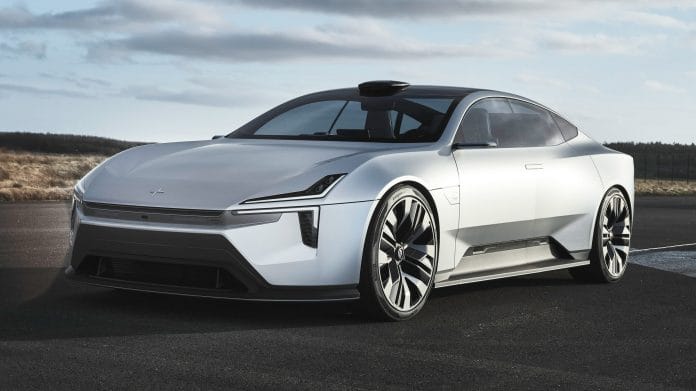
The Polestar Precept has moved from being a digital concept to a physical vehicle, as shown in these brand-new images revealed by the Swedish electric performance brand.
“Precept shows you where we’ll be heading – our design direction, our ambitions about sustainability, and the great digital user experience,” says Polestar CEO Thomas Ingenlath. “Precept showcases our future, not as a fancy dream or something from a sci-fi movie. This is our reality, to come.”
It’s a statement of intent and the clearest message yet from Polestar that a car like Precept is being considered for production, which would be a full-size electric saloon designed to rival the Tesla Model S. But, any production model based on it is still at least four years away, and technical specifications are being kept under wraps for now.
Described by Polestar as a “four-door grand tourer” – but featuring a shape that takes aim squarely at the Tesla Model 3 and Model S – the Precept is so named because it shows the styling direction that Polestar intends to take as it moves away from its initial models, the 1 and 2. Those cars are based on concepts from Polestar’s fellow Geely-owned brand Volvo.
No technical information has been released apart from confirmation of an all-electric powertrain and a wheelbase – 3.1 metres – that’s closer to that of the longer MercedesBenz S-Classlimo than either of Tesla’s offerings. It’s all but certain that the car is sitting on SPA2, the forthcoming new generation of the Volvo-developed large-vehicle platform. And judging by the front and rear overhangs, it’s likely to be around 4.7 metres long overall.
The styling looks to be enough of an evolution of what we’ve seen so far from Polestar to give the brand its own identity. At the front end, there’s a split headlight treatment and what Polestar is calling the SmartZone – a transparent panel positioned where the front air intake would normally be, that includes sensors and a high-definition camera that play roles in the car’s autonomous and safety systems. Above the SmartZone, there’s an integrated front wing which accelerates air over the bonnet, improving aerodynamic efficiency.
The flanks have subtle but clean surfacing, and a ‘step’ in the lower section that’s designed to mask the thicker floor required to house the Precept’s battery pack. The charging point appears to be integrated into the area just ahead of the driver’s door.
The rear features a full-width tail-light treatment that extends into vertical ‘aero wings’; these work in conjunction with a deeply scalloped tailgate panel and a rear diffuser to reduce the visual mass of the car.
The Precept has rear-hinged back doors, and this has allowed the B-pillar to be removed, improving access to the cabin.
The interior shows further differentiation from the Volvo-sourced treatments in the Polestar 1 and 2. Sitting at the heart of the dashboard is a 15-inch portrait-layout display that uses a new Android-based operating system that has been developed in conjunction with Google. The fascia is almost as minimalist and uncluttered as in the Model 3, although Polestar has added a 12.5-inch digital instrument panel behind the steering wheel.
In addition, it has replaced the rear-view mirror with a digital display that relays images captured on a wide-angle camera mounted at the rear of the vehicle. This is needed because the Precept lacks a conventional rear window; Polestar says it has used this design to fit wider-angle hinges on the tailgate to improve access.
The four-seat cabin makes extensive use of sustainable materials, including flax-based composites for the interior panels and seat backs that are 50 per cent lighter than conventional items.
The car’s seat fabrics are 3D-knitted from recycled PET plastic bottles, the bolsters and headrests are made from recycled cork vinyl and the floor carpets are produced from reclaimed fishing nets.
There’s no word on battery size or performance, beyond what Polestar calls a “large battery pack”. But the car does feature a Lidar sensor mounted at the top of the windscreen, and Polestar refers to “a next step towards increased driving assistance” – a suggestion that it could be being lined up to offer Level 4 autonomous driving capability.
This feature is also likely to frame the launch date of the car, though, because Lidar sensors of this size aren’t expected to reach even premium production cars until at least the start of 2023.
There’s no word yet on production plans, but Auto Express understands that while the car is unlikely to appear as the Polestar 3 (that model is expected to be an SUV), it could well make production by the middle of the decade



